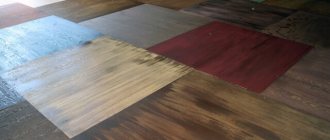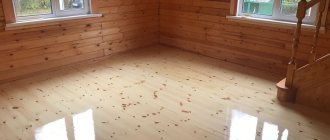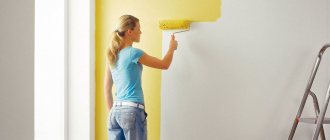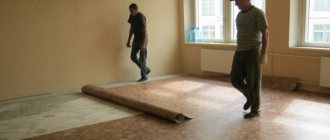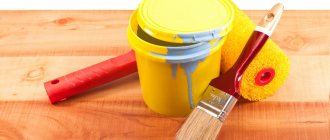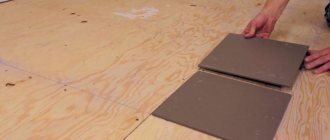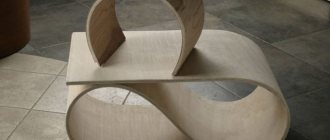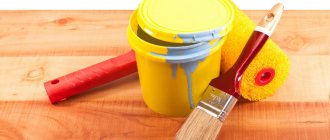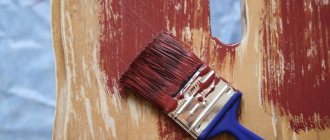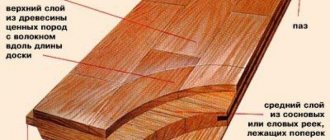Plywood is primarily used on floors as a preparatory layer, but it can also be used as a temporary covering. The question of how to paint plywood on the floor worries everyone who has decided to use this material as a floor covering, due to the fact that it needs to be protected from moisture. Plywood has become quite popular in use due to many positive qualities, including fairly low cost, strength, environmental friendliness, ease of use and aesthetics.
Painting a plywood floor may be necessary if you decide to leave this material as a topcoat.
Before you start painting the plywood, you need to prepare it. The prepared surface should be smooth and even. In addition, additional devices are needed to carry out such a process. For example:
- roller;
- brushes;
- spray gun;
- empty containers (you can use special ones, you can also use simple buckets or basins);
- sandpaper (if cleaning is necessary);
- soft sponges.
Preparation of the plywood surface
Increasing the service life of materials makes it possible to spend less money during routine and major repairs.
In our case, it is best to use acrylic paints and varnishes. Processing plywood before painting with a sander
Let's divide the process into several steps:
| Sanding and finishing edges |
|
| Priming and puttying | Process instruction:
Do not forget to remove all uneven surfaces with putty, and after it dries, you should clean and sand everything again. |
Advice: if the structure of the relief appears, it will not create interference. In this case, it is enough to apply one coat of paint over the primer.
Applying paint
Let's find out what is the best way to paint plywood inside a house. In this case, the main role is played by how the material will be used in the future. For example, the more layers of paint on the surface, the better the sheet will withstand the effects of humidity.
If you haven’t decided how to paint the plywood in your house or apartment, use a regular roller, brush and acrylic wood paint for interior work.
Advice: in places with high humidity, in particular outdoors, plywood sheets should be covered with several layers of paint on both sides, and not just on the outside.
How to varnish a plywood sheet with your own hands:
- take fine-grained sandpaper and carefully sand the desired area;
- Using a vacuum cleaner and a damp cloth, remove any remaining dust on the surface of the product, wait until it dries;
- apply paint to the surface of the plywood;
- top it off with varnish to create extra shine.
Tip: If you are using glossy paint, do not use varnish.
What tool will you need?
Before deciding how to paint plywood against moisture, let’s figure out which tool should be prepared for this.
Typically used:
- brush;
- roller;
- spray.
Thanks to the latter, it is possible to achieve quite decent quality of work, since it allows the paint to be evenly distributed over the surface. Its price is usually high, so foam rollers that do not have lint are often used in home construction. Brushes are used in hard-to-reach places.
Tip: Use masking tape to differentiate colors between each other on the floor or wall.
Selecting colors
Based on the type of thinners, they can be divided into the following categories:
- Alkyd paints are highly durable and can retain their original appearance for a long time. Due to the fact that they cope well with moisture, we recommend that you use them if you have not yet decided how to paint the plywood on the floor in your dacha.
However, to dilute them use:
- White Spirit;
- drying oil;
- turpentine.
They have a very pungent odor. Alkyd composition is not environmentally friendly, therefore, if you have not decided how to paint plywood outdoors, we recommend using it;
If you haven’t decided what to paint your plywood floor with, we recommend acrylic enamel
- Water-dispersion paints are diluted using ordinary water. In this case, all the signs of environmentally friendly compositions are evident, which is confirmed by the almost complete absence of any odors. After drying, a fairly strong, albeit thin film is formed on top.
There are several types of such paints:
- water-based - they can be applied to almost any surface. The compositions are resistant to temperature changes and can easily be applied to another type of paint. In addition, the material is generally non-toxic;
- latex - have high moisture-resistant properties, as well as abrasion resistance. Allows you to close cracks up to 1 mm. After application, a glossy coating is created. The disadvantages are that they do not tolerate low temperatures well and do not protect against mold;
- silicate – high quality coating at low cost of the compositions. Disadvantage - there is alkali, which is why it is necessary to take additional safety measures during work; they are not used with other paints;
- silicone - create very elastic coatings, allowing you to hide cracks up to 2 mm. Long service life, not afraid of moisture, so if you haven’t decided how to paint plywood against moisture, you can use them. The compositions do not react to temperature changes. But, the cost of the material is quite high;
Acrylic paint is best for painting indoors
- acrylic - after drying, a high-quality layer is created on the surface that is resistant to moisture;
- polyvinyl acetate compounds are used for rooms with low humidity. Please note that over time they may develop a yellow tint.
If you have not yet chosen the appropriate composition for painting plywood sheets inside a residential building, or have not decided how best to decorate plywood crafts, give preference to water-based paints that have the following characteristics:
- easy to apply;
- almost odorless;
- dry quickly.
In the photo - Belinka enamel for exterior use
For exterior work, it is better to use wood enamel or pentaphthalic paint. Before applying it, the plywood should be thoroughly dried, otherwise the composition will swell in damp places.
We paint from scratch
In this case, it is assumed that the slab will be completely prepared, and given how many stages there are in the preparatory process, we can say that treating the plywood before painting is the main and most important part of the entire painting process in general. Before you start painting directly, you need to go through several stages, briefly it looks like this:
Before you start painting directly, you need to go through several stages, briefly it looks like this:
- The surface is sanded with 80 grit.
- Acrylic primer for wood is applied.
- The leaf is dried.
- Processing is carried out with acrylic wood putty.
- Drying again.
- Once again the surface is sanded and primed.
- Coloring
Example of material for acrylic impregnation
Grinding
Sanding is necessary in order to completely eliminate any unevenness from the surface.
And the instructions say that the work is carried out here in several stages:
- The first sanding is carried out with coarse sandpaper No. 80 - 100. Moreover, it is performed strictly across the direction of the texture of the plywood board.
- But the second grinding will be necessary to give the plane an ideal state for varnishing and it is done with fine-grained sandpaper along the texture of the material.
- Next comes the preparation of the edges of the slab. To do this, they are planed from the edge to the center, sanded and coated with acrylic paint several times.
The edges of the material are processed especially carefully
Primer
Once the surface of the slab is in ideal condition for priming, you can begin to apply impregnation. A simple paint roller is used for this, and acrylic impregnation and putty are used for application.
Below are the advantages of this processing:
- The absorbent surface of the plywood is finally leveled.
- The putty allows you to completely close all microcracks and defects in the veneer.
- Increases the service life of plywood sheets.
- Increases wear resistance and improves protection against mechanical damage.
Coloring
Before painting, even during sanding, it will be necessary to decide whether it is necessary for the structural relief to appear, since this determines how and with what to treat the plywood before painting, as well as how many layers to apply during painting work.
As for the aspects of painting, it all depends on how the plywood will be used. The thing is that coloring not only gives the material a new bright color, but also acts as protection against moisture. Therefore, if the material will be used in places where the humidity level is above average, it is recommended to paint it on both sides.
For finishing work inside residential premises, it is recommended to use water-based acrylic paint
It does not have a strong or unpleasant odor, dries quickly enough, is not dangerous and is easy to apply, which is important for a person who is not particularly familiar with painting
If it is necessary to paint plywood outdoors, then enamel paints and varnishes are quite suitable for use, for example, pentaphthalic paint, which dries well outdoors and is easy to apply.
Pentaphthalic paint, perfect for painting outdoors
Paintwork materials may already be in a ready-made color or in a base color, then you will have to do tinting. It is best to do this in the store where the dye is purchased.
For painting, you can use three methods of applying paintwork:
A simple brush. This option is good if you need to apply several layers. This way, divorces will not be visible.
Paint applied with a brush
- With a roller. For this application method, you will need a foam roller, without lint.
- With a spray gun. The highest quality application option, however, it will require certain knowledge.
As for the laminated surface, painting laminated plywood is absolutely no different from the usual process. Here are the same preparation procedures, which eliminate all the features of the laminate. Sanding and impregnation increase adhesion to paint, so the issue of laminated material is not so relevant.
https://youtube.com/watch?v=zzZZ1z-UPcY
And yet, if painting is not done with a spray gun, you will still have to use a brush to apply paintwork to hard-to-reach places. Otherwise, coloring is carried out like any other material. And it’s quite easy to do it yourself, of course, after preliminary preparation.
Painting a veneer slab can give rise to a rampant design idea
Paint and materials
When choosing materials and tools for work, you should consider the following:
- Future operating conditions of painted plywood. If the sheet will be in an open space or in a damp room, it is better to paint it with acrylic pigment. The emulsion is applied twice, all sides of the canvas and ends are processed;
- Characteristics of the material to be painted. If the canvas contains phenol-formaldehyde glue, facade paint for plywood is suitable;
- Is a spectacular appearance important? Plywood for furniture is painted with water-based compounds;
- Conditions, scope of work. The choice of tool is determined by the nature of the surface, its area, and accessibility to painting.
Antiseptic treatment protects plywood from fungi and mold
Pigments
How to paint plywood inside a house? Water-based compositions, for example, acrylic, are suitable for this. This pigment dries quickly, does not smell, and is easily applied to the treated surface. If the plywood sheet will be used outdoors, it is better to paint it with ordinary wood enamel. This paint is called pentaphthalic. The composition is easy to apply and dries quickly in a warm room. Paints are available for sale ready-made or as a base, which requires independent tinting.
The painted sheet can be varnished. This treatment gives the surface additional gloss. In this case, it is important to ensure that the wood panel is completely dry before applying the composition. If the pigment already contains gloss, varnishing is not necessary. Alkyd-urethane varnish is considered the best option for the combination of price and quality. Urethane and polyurethane compounds are also suitable for processing. They have increased strength characteristics and higher cost.
The composition should be applied in two layers if a rich shade is required.
Auxiliary materials
What tools can you use to paint a plywood sheet? The fabric is processed using:
- Sprayer. The pigment is evenly distributed over the surface. The downside of the tool is its high cost;
- Roller. For work, it is better to choose a standard foam tool;
- Tassels. The tool is well suited for painting hard-to-reach areas.
Features of substances
Ceiling painting scheme.
Plywood is a material that is very easy to paint. By performing these works, depending on your design decision, you will be able to:
- preserve the natural appearance of the wood structure;
- paint with opaque paints and varnishes that will completely hide the base.
To preserve the natural color of the wood, it is enough to cover the plywood with several layers of furniture varnish.
Using various stains, you can emphasize the structure of wood and imitate the color of different types of wood.
There are stains:
- water based;
- alcohol based;
- nitromordants;
- dry mixes.
Stain colors.
To make the color more saturated, plywood can be coated with several layers of stain. In order to achieve a more even color when staining, it is better to slightly wet the surface of the plywood, and for deeper penetration into the depths of the wood, the stain can be heated. The first layer should be applied along the fiber structure, the second - across.
You can apply the stain using a swab, a hard brush or a spray. Please note that a wet surface will look darker than a dried one.
After painting, the plywood must be dried. Water-based stain dries within 24 hours, while alcohol-based stain dries in 15-30 minutes.
Staining performs only a decorative function. To give plywood moisture-resistant properties, it is necessary to additionally coat its surface with varnish or drying oil.
When plywood is treated with stain, the wood fibers swell. After drying, you can feel that the surface has become rough. Therefore, before varnishing, plywood must be treated with fine-grained sandpaper, and then wipe the sheet with a dry cloth or vacuum to remove small particles.
Questions
How to paint plywood inside a house?
For interior decoration, various water-based paints are used - acrylic, latex. You can paint the canvas with wood enamel, otherwise called pentaphthalic. The composition is easy to apply, penetrates well between the fibers, and dries instantly.
What paints can you use to paint on plywood?
The wood canvas holds oil and acrylic compositions well, even gouache and watercolor. The sheet must be at least 6 mm thick. The surface must first be primed or impregnated with drying oil similar to oil.
Painting on the surface
How to paint plywood white?
To obtain a high-quality white surface without visible minor defects, matte paint is required. Glossy compounds are less able to hide flaws in the base. Before work, you also need to carefully prepare the surface.
How to paint plywood on the floor?
Elastic paint is well suited for finishing flooring. This composition has a rubber-like structure, a shiny appearance, and is resistant to ultraviolet radiation. The pigment forms a thin film, hides minor flaws, and conceals unevenness.
How to paint plywood against moisture?
The easiest way to protect the surface from moisture is to impregnate the sheet with drying oil or acrylic varnish. Another effective, but more expensive option is to paint the canvas with epoxy resin.
How to paint plywood furniture?
It is better to paint furniture items with water-based compounds. Such emulsions are easy to apply, dry quickly, and do not have a strong unpleasant odor.
Plywood sheet is an inexpensive material widely used for various purposes. Proper surface treatment increases the service life of the product, be it a floor or furniture made of plywood. Taking into account the characteristics of consumables allows you to quickly paint and avoid unpleasant consequences.
Conclusion
Plywood is ideal in terms of price to quality ratio. At its low cost, it will allow you to make a practical and beautiful floor or a reliable basis for an expensive coating. In addition, it will not be difficult to do it yourself (also find out how to level the floor in an apartment).
You can lay parquet
Regardless of whether you choose such a material as an outer covering or as a rough layer, in any case, wood-laminated board will become an important and high-quality component of your floor covering!
Primer
Alkyd primer is most conveniently applied with a roller. Once it's dry, you can start painting the plywood with alkyd or acrylic paint. The drying time for alkyd paint is slightly longer than for acrylic paint.
If you reduce the number of preparatory steps, a distinct relief may subsequently appear on the surface, which some even welcome. In exceptional cases, plywood on the floor is opened only with primer and paint.
Before covering the plywood on the floor with any dye for moisture resistance, it must be thoroughly sanded. The optimal sandpaper for this purpose is coarse sandpaper No. 80-120. This processing, carried out along the fibers, smooths out all the irregularities and roughness so that the surface becomes smooth. Additional sanding of the plywood with finer-grained sandpaper will give the plywood canvas absolute smoothness. Processing is also carried out along the fibers.
A layer of acrylic primer can be applied to a smooth surface.
Applying a primer and covering with a continuous layer of putty is carried out in order to:
- ensure uniform absorption throughout the entire plywood sheet;
- fill the cracks and voids in the inner surface of the glued veneer;
- increase the service life of the plywood covering;
- protect from destruction.
What do you need to know before installation?
To check the room for humidity, lay out a film.
How to make a floor from plywood in compliance with all technological requirements, so that it lasts a long time and does not have to regret the decision to use such a material?
To do this, you need to perform several steps and only then proceed with installation. First of all, it is recommended to acclimatize the sheets to the place of application. To do this, the material must be brought into the room that is planned to be covered.
The material must be allowed to rest at room temperature.
The period after which work is allowed to begin depends on changes in temperature and humidity conditions. If the conditions are almost identical, installation can begin the next day. With a difference of 10 degrees or more, acclimatization will take more than a week. All this time, the sheets should be stacked in a horizontal position.
While the material is acclimatizing, you can check the floor surface for the presence of condensate vapor. To do this, a polyethylene film is spread over an area of 1 m2, the edges of which are pressed tightly to the floor. The central part should be raised by 5 - 10 cm. Then you need to observe and draw appropriate conclusions from what you see:
- The film fogged up within 1 day - it is not recommended to make plywood flooring for this room.
- Within 2–3 days, small drops appeared. The concrete base must be insulated and covered with waterproofing. It is recommended to disassemble wooden floors, dry them, treat them with antiseptics and eliminate the cause of high evaporation. Otherwise, they will rot in 5–6 years. Only after this can you begin laying plywood sheets.
- In 5 days no drops of condensation appeared - a plywood floor can be made using all known methods.
Recommendations for applying varnish
In addition to paint, moisture-resistant plywood for flooring can be sealed with varnish. However, before applying it, the unpainted surface must be sanded with fine-grained sandpaper. Dust generated during veneer processing should be eliminated, after which you can proceed directly to varnishing.
If the varnish is used to add gloss to a previously painted plywood floor, then you just need to make sure that the surface is completely dry. By the way, it is not necessary to apply varnish to paint with a gloss effect.
Alkyd-urethane varnish is considered optimal in terms of price-quality ratio. However, if desired, the floor can be opened with both urethane and polyurethane varnish, which have higher strength characteristics, but are also more expensive.
Varnishing includes a number of stages:
- Before applying varnish, the surface is covered with primer in 2 or 3 layers.
- Alkyd-urethane varnish for priming should be diluted 10-12% with white spirit. 1 liter of such soil is enough to treat 13-17 m2 of surface.
- Water-based varnish is diluted in a ratio of 4 parts water to 1 part varnish. 1 liter of this mixture is enough for 8-13 m2 of surface.
- As soon as the primer dries, you can apply 2-3 layers of varnish. 1 liter of any varnish is usually enough for 9-13 m2 of surface.
- The time interval between application of layers is indicated on the varnish packaging. As a rule, alkyd-urethane varnish dries in 5 hours. After a day you can already walk on the varnished floor, and it will take about 4 days for complete drying.
- Water-based varnishes partially dry in 12 hours, so they can already be walked on. However, it will take about a week to dry completely.
How to varnish wood
How to varnish wood and plywood?
Varnishing is the application of a transparent varnish film to a wooden surface, giving the product a decorative appearance and also protecting it from dust, dampness, and minor mechanical damage. The color and transparency of the varnish film are important for preserving the texture of the wood being finished. Varnishes are applied to the surface with a brush or swab, spraying, dipping, pouring. They produce linseed oil, nitrocellulose and other varnishes. For varnishing wood products, furniture nitrovarnishes NTs-218, NTs-221, ntsts222, NTs-223, NTs-228 are usually used. They are light, give an even, smooth, durable glossy film, applied with a brush, spray paint and pouring. Nitrovarnishes NTs-49, NTs-214M, NTs-243 give a matte film.
Solvents N-646, 647, 650 are intended for diluting nitro varnishes to working viscosity and smoothing out the shading of small scratches on nitro coatings that occur when grinding the surface. Polyurethane varnishes UR-2112M, UR-271, UR-2104M, UR-2124M have a good shine. moisture resistance - varnish UR-277M with solvent RL-277. Oil varnishes are solutions of natural or synthetic resins in drying vegetable oils with the addition of driers and solvents.
Of natural resins, rosin, shellac, amber, copal, dimmaru, etc. are used. But since these materials, except rosin and amber, are scarce, they are replaced with synthetic resins (polymers) - alkyd, perchlorovinyl, phenol-formaldehyde, etc. Most often for finishing For wooden surfaces, light varnishes GF-166 (glyphthalic) and PF-283 (pentaphthalic) are used. They provide a uniform, glossy, transparent film. Apply with a brush or spray gun. The first layer of varnish is applied in one direction, the next in another, etc. Apply the varnish with a wide, soft, strong brush in an even, uniform layer, without bubbles or smudges. When varnishing a product by pouring varnish, the poured surface is held horizontally and the inner surface is rotated. When varnishing by dipping, you must allow the varnish to drain from the product. The drips are corrected with a brush.
During the varnishing process, it is recommended to adhere to some established rules that will help the novice craftsman perform this work correctly.
1. You should work with varnish in a well-ventilated area or under a hood, since all paints and varnishes are poisonous.
2. The optimal ratio of varnish and thinner should be from 9:1 to 5:5. Thinner can be added as layers increase, especially when applying the latter. Coating with undiluted varnish is very rough in appearance, and also gives the product a strong shine.
3. You need to apply the varnish in a thin layer (with a large amount of solvent), then there will be no air bubbles and the tampon marks will be less noticeable.
4. Varnish should be done quickly, without stopping, as the varnish dries quickly.
5. You cannot level the surface of the coating by dripping varnish onto it - any sagging is very difficult to sand off.
6. Small irregularities on the surface of the coating can be easily eliminated with a swab moistened with white spirit or liquids NTs-31Z, RME.
7. Before leveling (sanding) the varnish surface, a thin layer must dry for 24 hours, a thick layer - at least 48 hours. Having applied the first layer of varnish, it is dried and sanded dry. Then two more layers of varnish are applied, dried again and wet sanded. To do this, sandpaper screwed onto the block is moistened with a little soapy water and sanded without pressure strictly along the fibers, wiping the surface with a rag from time to time. Next, the application of each layer of varnish is alternated with wet sanding until no traces of tampons remain on the surface sanded to a uniform matte sheen. The last layers are sanded with fine-grained sandpaper to avoid scratching the coating. A total of 6 - 8 layers of varnish are applied.
Installation of plywood covering
It can be broken down into the following stages.
- Cutting the material. Before it starts, measurements and calculations are carried out. Sawing of sheets should be carried out in such a way that the result is as few joints as possible. In addition, the dimensions of the elements are calculated taking into account clearances for the damper. Between adjacent sheets they should be 3-4 mm; between the outer elements and wall surfaces the distance increases to 8-10 mm. Damper joints are needed so that the plywood sheets do not swell under the influence of external conditions when the wood expands. Cutting should be carried out exclusively on a rigid and level base. For large floor areas, the recommended element sizes are 500x500 or 600x600 mm.
- The blanks are inspected. If the ends become delaminated when using a jigsaw, they should be sanded.
- The resulting elements are numbered in accordance with the intended layout. On the basis, a layout diagram of the workpieces is outlined.
The laying process itself has a number of subtleties that should be taken into account when laying elements.
In some cases, plywood underlayment is required on a wood floor. It is almost always placed if the room being renovated is located on the ground floor. Individual strips are fixed with construction tape. Holes for self-tapping screws must be marked and drilled before laying plywood sheets. At the exit from the workpiece, they are countersunk to fit the caps, for which a drill of a slightly larger diameter is used
Please note: the fastener heads must be recessed into the material so that they are flush with its surface. If they go a little deeper, the depression needs to be leveled, for which construction plaster can be used. First of all, plywood is laid in niches and any kind of protrusions.
Then installation is carried out from the center to the edges. Ventilation vents do not close.
At the end of installation, the smoothness of the resulting surface is checked with a level. As a final touch, it is scraped.
Self-painting technology
As noted above, before properly painting plywood, you should choose a tool. It is better to paint large wood boards using a sprayer, and medium-sized plywood can be treated with a roller. Brushes are needed to paint a narrow space, while a sponge can be used to cover small-sized home decor.
Painting plywood with a roller
The painting technology looks like this:
- Creating the required consistency. Before painting plywood with acrylic paints, they can be diluted with water. If the work is carried out with enamel, it is diluted with solvent or white spirit.
- First, you need to use a brush, treating all hard-to-reach places with it: this procedure will allow you not to repaint the base in the future.
- Using a convenient tool – a roller or spray gun – you need to paint the remaining part of the surface. Painting the wall should occur with vertical and horizontal movements.
- After the first layer has completely dried, you can go over it again with the same colored paint for brightness.
- The last stage is varnishing. Regardless of the style, purpose or color scheme, plywood products must be varnished. It can be either glossy or matte. After drying, the material is ready for use; if necessary, you can coat the plywood with another layer of varnish.
Plywood can be painted antique: to do this, it is enough to apply black paint after priming and sanding, and after it dries, apply light paint. When the surface is dry, it must be treated with coarse sandpaper and varnished. This option is suitable for painting antiques, loft-style interior items, and vintage collectible furniture.
In the photo: a spray gun is a convenient tool when painting without visible brush marks is required. It is also useful for large volumes of work.
When working externally, for example, on a summer cottage when painting a plywood veranda, as well as when using wood in a bathroom, you should additionally treat the surface with antibacterial solutions - they will protect the material from fungus.
Decorative items turn out beautiful: the painted material can be used as a basis for further creativity. You can depict a flower or landscape on it, using the product for a tabletop in the future. By skillfully using an old bristle brush, you can visually transform plywood into marble, plastic or metal, creating an imitation of them on the surface with sharp transitions. A handy tool like a laser level will help you make precise markings on the surface to be painted.
Varnishing
Following simple tips and rules will help you paint plywood with various types of paints efficiently and beautifully. A competent choice of primer, putty, paint and varnish will help extend the life of the product, maintaining its original appearance.
Little secrets
You can paint laminated plywood to imitate wood. How to do it? The simplest option: pour dark brown and beige powder dye into the varnish, but do not stir until smooth. When applied to a plywood sheet, this mixture will create an imitation of wood. It is possible to use other combinations of light and dark.
When you need to apply several different colors, it is advisable to paint the surface with one color, and after drying, apply the design, sealing the areas not intended for painting with masking tape. To add shine and additional strength, it is recommended to apply varnish after the paint has dried.
These simple recommendations will help you decide how and with what to paint plywood inside and outside the house.
